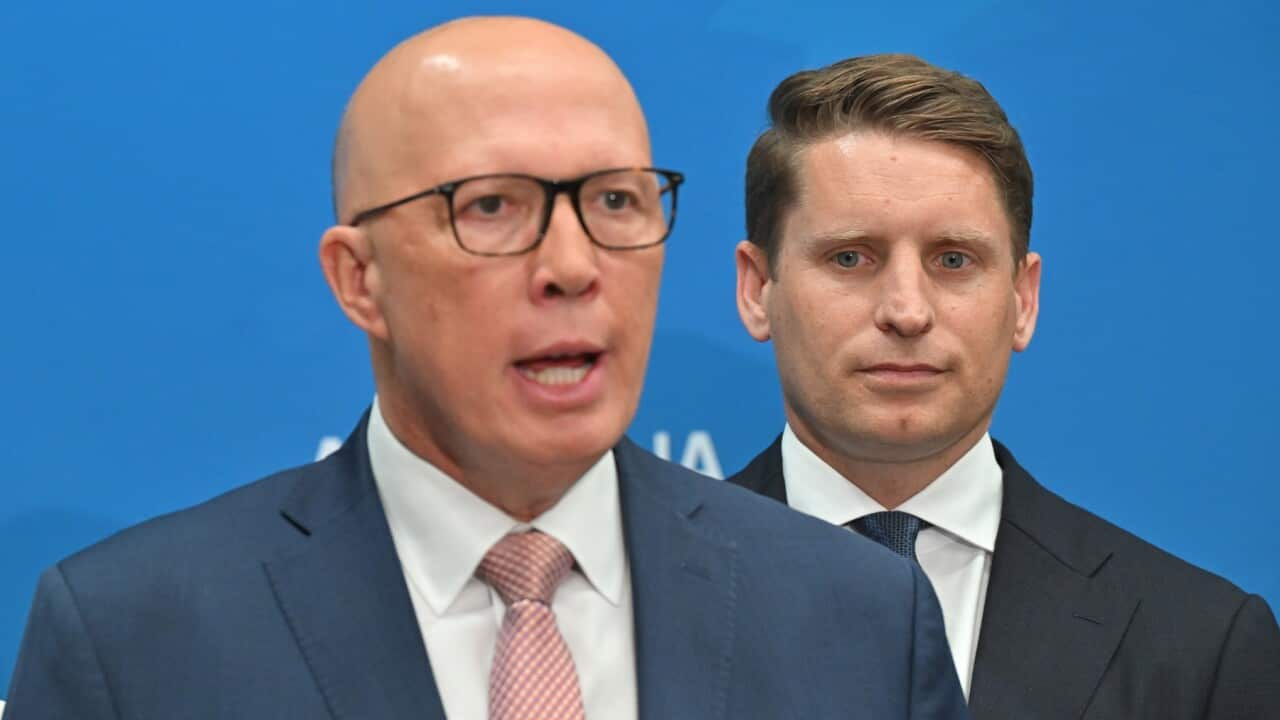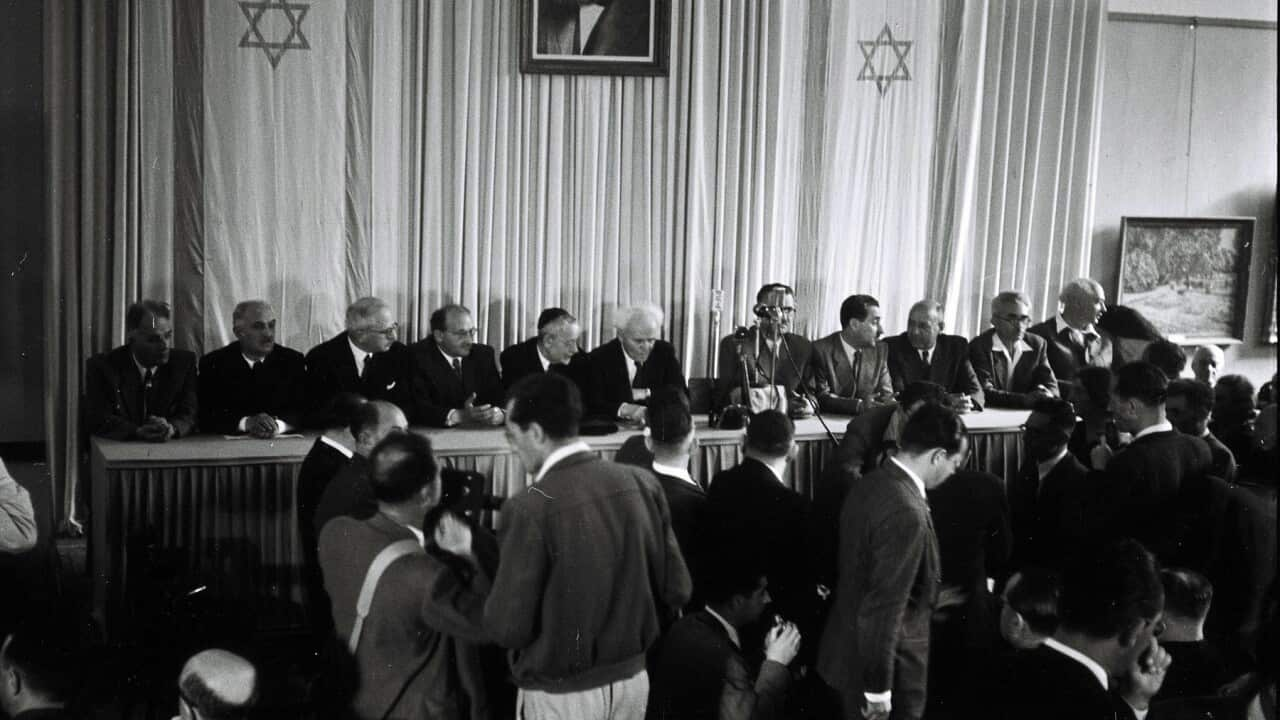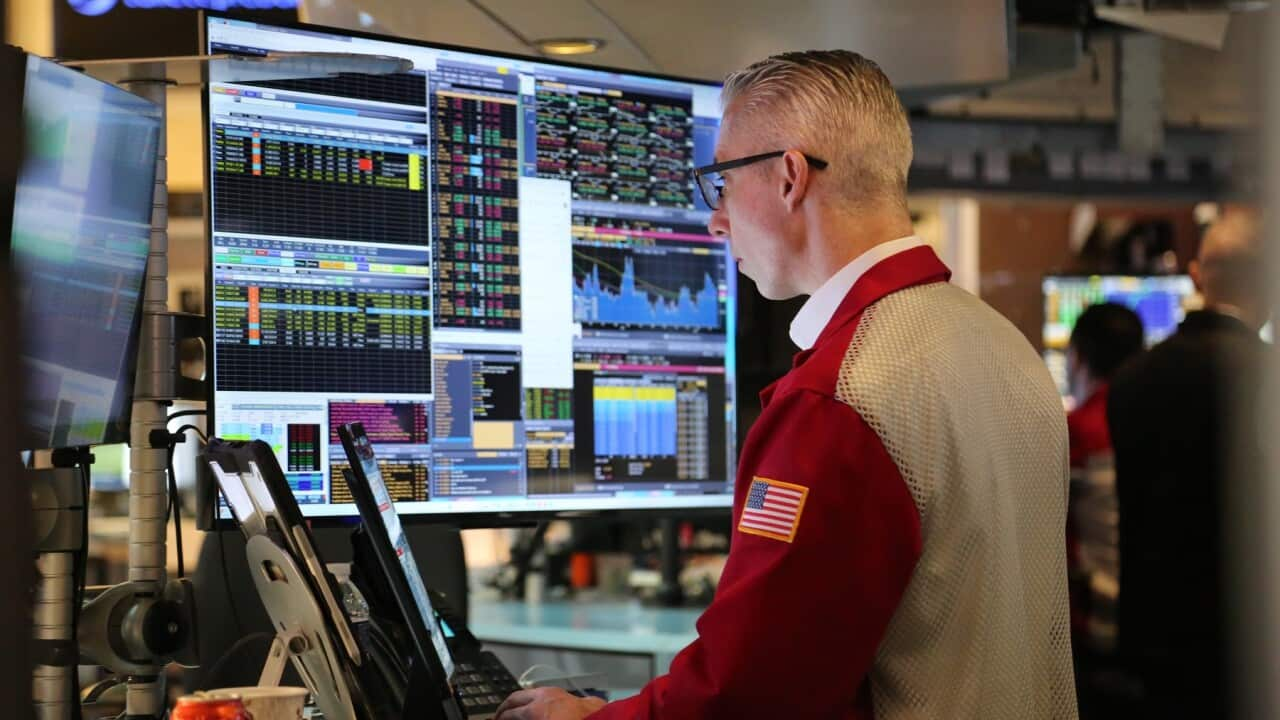Listen to Australian and world news and follow trending topics with SBS News Podcasts.
TRANSCRIPT
"The single most important task for the Australian government is to keep the Australian people safe."
That's Opposition Defence spokesman Andrew Hastie.
He and Opposition Leader Peter Dutton have announced the Coalition's plan to increase defence spending to 3 per cent of GDP within a decade, if elected.
"It will be an important expenditure, because we need to keep our country safe, and if we're to preserve peace and stability in our region, if we're to be a good ally with our partners, then Australia needs to invest in defence."
The Coalition is promising to increase the spending to 2.5 per cent of GDP within five years, which it says will cost $21 billion, before reaching the 3 per cent target in a decade's time.
That would equate to more than $134 billion annually.
Defence spending is currently 2 per cent of GDP, with Labor planning to grow it to 2.2 per cent within five years, and 2.35 per cent in just under a decade.
So what's the 3 per cent target about?
"GDP has long been used as a very informal proxy for defence spending. It's not a great measurement. It can go up and down as we move into growth periods or recession. It is untied to what we might spend in an actual conflict. But it tells us how much of the budget is the government actually spending on our security. And because it's a neat, round, kind of high-level number, it's often very attractive."
That's Associate Professor Andrew Carr from the Australian National University.
"Unfortunately, it doesn't really tell us what they're spending it on or how directly that addresses the big security problems we face."
Professor Carr says Australia's defence spend as a proportion of GDP peaked during the Second World War at more than 30 per cent.
In the 1960s and 1980s, it sat around the 2-3 per cent mark, and it was at its lowest in 2013, at about 1.6 per cent.
But he says there are more important things than a number.
"I think it's a necessary and an encouraging move. It'd be nice to see more focus from the Coalition on what they're intending to spend it on, you know, what are the big strategic problems that they think need to be addressed, rather than looking at kind of neat round numbers as if that is a useful proxy for our overall security."
Three per cent is also a number that's repeatedly cited by the United States Government.
President Donald Trump told NATO members to lift their defence budgets in response to Russia’s ongoing war in Ukraine, whilst a senior US Defence Official called for Australia to rapidly increase its spend to 3 per cent as the two countries tighten defence ties under the AUKUS pact.
Defence expert with the Australian National University Jennifer Parker says there are other reasons for spending to be boosted.
"That is not the reason we should be doing this. We should be doing this because the strategic circumstances are dramatically changing, and we just don't have the capabilities in the defence force that we need, despite the hard work of women and men of the defence force."
She says increased funding is important in the current situation.
"The limited spending on the defence budget is one of the key constraints that is impacting the ability of our defence force to have the capabilities that they need to protect Australians in these strategic circumstances. It's not just about preparing us for conflict, but a stronger defence force means the chances of conflict are less likely."
So what's the money actually for?
The Opposition Leader has a wishlist.
"Drone capability, guided weapons, our munitions, and our capability across most platforms, including frigates. But we're not announcing procurement contracts from opposition."
But he's offered no specifics - which has been criticised by Defence Minister Richard Marles.
"What we have is a complete absence on the part of the Coalition to do any work in relation to defence policy at all. Throwing out a number and doing nothing to back it up, not explain how you will raise the money or how you will spend it, does not equate to increased defence spending."
He says Labor will continue to assess the needs of the Defence force.
"There was no single new capability announced in the Coalition's defence policy today. We do believe that there needs to be an increase in defence spending. That's why, under Labor, you've seen the biggest peacetime increase in defence spending in Australia's history."
It's not clear how the opposition will pay for the plan, although it flagged its plan to reverse Labor's tax cuts as a way to save $17 billion over the forward estimates.
Peter Dutton is confident there is space for other cuts in the budget.
"We’ll find savings, as we've been clear, as John Howard did in '96, where Labor has invested in programs where that money is not being spent efficiently, and we've given guarantees in relation to health and education and other areas of Commonwealth expenditure."
It's a late announcement from the Coalition.
Early voting has already opened, with a record half a million voters casting their votes on the first day of pre-polling.
The opposition is applying additional pressure to Labor as those votes start to roll in.
Labor's national security record has been questioned throughout the campaign, after China conducted military drills in the Tasman Sea without prior warning, and a Chinese vessel circumnavigated Australia.
The opposition's defence spokesman, Andrew Hastie, was also forced to clarify his stance on women in the defence force.
"The Coalition policy is that all combat roles are open to women. It's been a long-standing position. The one thing that we will insist on is high standards, because in combat, there's no points for second place, so we need to be able to win every fight that we go into."
The former soldier told Sky News in 2018 that he believes close combat units are better when they are exclusively male.
Now he's insisting the roles will be open to all Australians.
"When I think about some of the things I had to do. Live fire drills, where you practice a man down, very anaerobically, very aerobically intensive, you need fine motor skills, you're firing live rounds. I remember picking up an 85 kilo mate with my pack and webbing and my legs buckling. I said what I said. But the thing that the Australian people need to know that under a Dutton-led coalition government, we will have a policy that is open to all Australians for combat roles."













